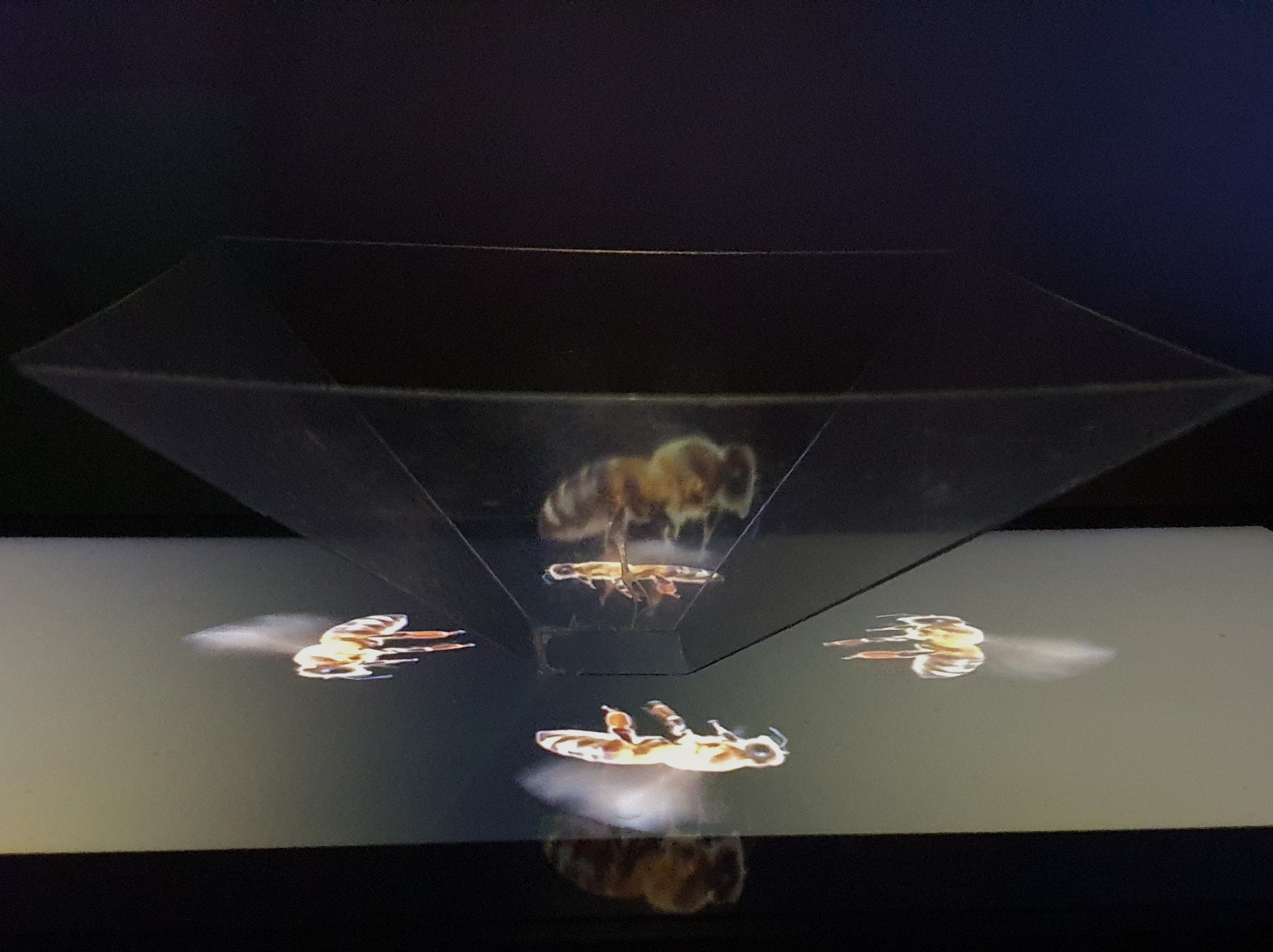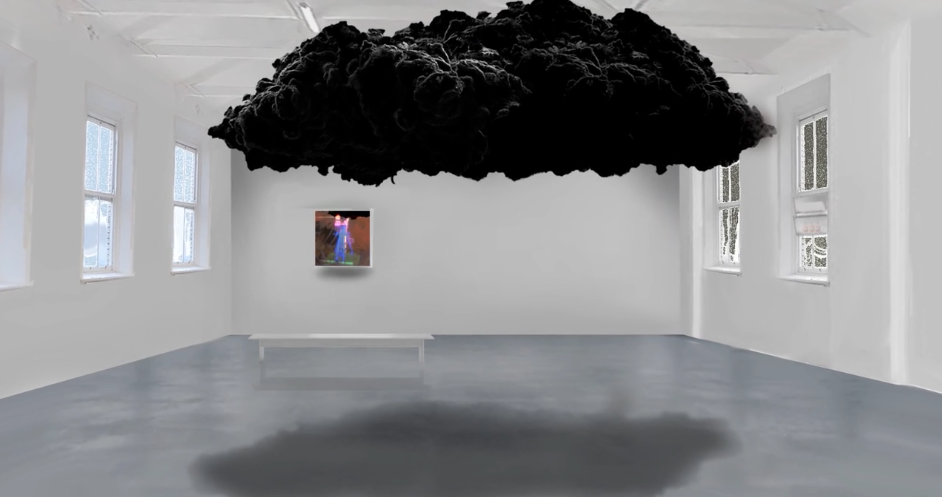 Close up of Bee hologram installed in 'First View' exhibition at Garter Lane Art Centre, Waterford City, Ireland, 2019. Digital image.
Close up of Bee hologram installed in 'First View' exhibition at Garter Lane Art Centre, Waterford City, Ireland, 2019. Digital image.
Sensory Response: Susie Kelly’s Holograms
Interview by Olivia Ann Carye Hallstein
Through multi-sensory works that enrapture and bring the viewer into a space beyond the imagination and into the real, Susie Kelly addresses both environmental and geopolitical topics that grip the whole sensory body. She brings eco-art into the digital era through holographic works and new media. The inspiration she takes from her environment and as a grandmother brings home that human-made climate issues are prevalent and will be passed on to the next generation. Through her daring body of work, she reverberates and heightens the discussions within her community to create a global and existential grip that only art can accomplish.
 Miasma, 2020, Installation, media includes recycled plastic, recycled net, wire, wool (used to sew recycled plastic fibre to net), holographic imagery in lightbox.
Miasma, 2020, Installation, media includes recycled plastic, recycled net, wire, wool (used to sew recycled plastic fibre to net), holographic imagery in lightbox.
In Hologram, you tackle the oil industry with a large cloud of smoke made from recycled materials. What created the inspiration for this piece? Has your area also been affected by rigging and air pollution?
In a way, Miasma is a celebration of Ireland doing the right thing. Ireland is a tiny, naturally beautiful island, yet gas companies have caused landslides and untold environmental damage on the west coast. Peat was excavated from bogs by the state and individuals until very recently, destroying natural habitats, local flora, and fauna. Our Environmental Protection Agency has carried out environmental impact studies for fracking. In 2013 oil was discovered off the coast in areas of natural beauty. Opinions were split, with some foreseeing great wealth but much more anticipating destruction of natural habitats and damaged biodiversity. In 2019, Ireland announced the decision to end exploration for fossil fuels at the UN climate summit making us one of the first countries worldwide to get out of oil and gas production due to the impact on climate. I suppose that announcement coupled with Irish visual artist John Gerrard’s virtual artwork, Western Flag, was my inspiration for creating Miasma.
As an artist I believe part of my job is to engage people’s imaginations, to inspire affection and empathy for the ecosystem of which we are all part.
You describe how your interest in ecologies and ecological destruction stems from concerns revolving human impact and your grandchildren’s future. Can you discuss what your hopes are to counter those impacts?
Artists and young people are where my hopes lie to counter the causes of rampant biocide and consequent climate change. As an artist I believe part of my job is to engage people’s imaginations, to inspire affection and empathy for the ecosystem of which we are all part.
People like Greta Thunberg, groups such as Extinction Rebellion, and blogs such as ecoartspace offer hope and action. Young people are more aware and engaged with the issue than ever before. For example, 33 European governments have been ordered by the European Court of Human Rights to respond to a ground-breaking, crowd-funded climate change court case initiated by four Portuguese children and two young adults. They argue that governments are not moving fast enough to decrease climate destabilizing greenhouse gas emissions. To protect their “future physical and mental wellbeing, to prevent discrimination against the young and protect our rights to exercise outdoors and live without anxiety”. Should the court decide the young people are correct, states will be legally compelled to act and enforce action to address emissions for which they and multinationals operating within their borders engaged in operations such as extractive activities, trade, and deforestation are responsible.
My next body of work is about symbiosis and how we are all part of a whole. I think that the crux of the problem is that as technology has progressed, western civilization has separated itself from nature. I hope that by highlighting interdependencies we can move forward symbiotically.
 Close up of hologram exhibited at GOMA, Waterford City, Ireland, Dec. 2020 - Feb 2021. Digital image.
Close up of hologram exhibited at GOMA, Waterford City, Ireland, Dec. 2020 - Feb 2021. Digital image.
What atmosphere would you like to create with your hologram installations and videos? Would you like people to feel intimidated or forewarned or informed?
Strangely, I anticipated people might feel a sense of foreboding or oppression when viewing the cloud, prompting a review of their contribution to climate change, and perhaps curiosity with the holograms. The temptation to be didactic could be bubbling under the surface but I am happy if viewers take away a sense of wonder and curiosity, a wish to know more, an instinct that there is more to know. The experience is that the cloud provokes play, inviting people to touch it, lie under, and be photographed with it. People also relate it to mental health or the pandemic. With Hologram, people are charmed, mesmerized, and curious.
In the end I felt the idea of birdsong and oil combined well with the ability to touch the materiality of the cloud. They caused that incongruent, disruptive sense of something not being quite right that might prompt further reflection.
Hologram is a multi-sensorial work using smell, sight and sound. How has your experience been working with sensorial curation? How has your approach been different while working with multiple senses?
The idea of a multi-sensorial exhibition was something I had been percolating for some time. I had previously worked with sound and incongruence and wanted to stretch that further to include olfaction and touch senses. Creating a relatively calm, uncluttered space was important, to allow the soundscape and olfactory elements to be experienced. Accessibility is something to be seriously considered when creating an exhibition, particularly a visual one. Whether someone with sight or hearing challenges attended, they would get something from it. The olfactory element was something I grappled with, whether to go ahead with the scent of burning oil or to try to incorporate natural smells. In the end, I felt the idea of birdsong and oil combined well with the ability to touch the materiality of the cloud. They caused that incongruent, disruptive sense of something not being quite right that might prompt further reflection.
 Maya process shot, 2020. Digital image.
Maya process shot, 2020. Digital image.
What do you find most inspiring about the pumpjack? What was your process in digitizing and animating it?
The pumpjack is a strong visual shape and structure. It is almost universally recognized as something to do with oil and fossil fuels. It also evokes in my mind the human heart, its automaticity, the cyclical nature of the pumping mechanism. So, for me, the cyclical, visceral nature of the movement evokes the human microbiome. You cannot help but be mesmerized by it. All of the parts in synchrony. The pumpjack was created using Maya software in three distinct phases, Modelling, Texturing, and Animating. This process was repeated for the iterations where it appears to transform from pumpjack to playground. Each was rendered and exported to Adobe Premiere Pro as png groups and edited into sequences. Following that, I copied each of the sequences x4 to create the holographic video. I used two methods to play the holograms, a trapezoidal acetate projector I made to fit a 19” square screen and a hologram fan. I have a slight preference for the acetate method. There are many more technical modes of projection, but I felt those two were most suitable for this artwork.
Reusing materials that do not cause further environmental damage is something I adopt as an artist to minimize my personal CO2 number. This remains a priority in my practice.
How has working with digital technology and installation helped you create your message?
Creating works of a relatively monumental scale, reflecting the “hyper-objectness” of the climate change/symbiocene issue, reusing materials that do not cause further environmental damage is something I adopt as an artist to minimize my CO2 number. This remains a priority in my practice. The idea of creating digital work that augments and speaks to that priority came from a desire to communicate the circularity of the issue, and possible solutions, without exacerbating in any way, the problem. It was something I needed to resolve for myself as a practicing artist.
Audiences are more open to digital work now than in the past. Learning to use various software applications enabled me to be nimble, to adapt my practice. I find that working with digital technology enables unlimited experimentation when compared to physical material outcomes in the studio. A common misconception is that making digital work is easier than the physical. As somebody who makes both, I am keenly aware that it takes high skill levels and knowledge of the principles of visual art to create successful digital artworks in much the same way as it does physical works. Granted, mistakes are relatively straightforward to rectify, I often thank the universe for backups and the undo button!
 Process shot creating pumpjack structure in Maya. 2020. Digital image.
Process shot creating pumpjack structure in Maya. 2020. Digital image.
What have been the most rewarding and most challenging aspects of this work?
Most rewarding has been two aspects. The first is having the model work as a somewhat believable entity. There was a huge amount of work involved. Bearing in mind I was learning the software ‘on the fly,’ I spent over 500 hours working on screen, so it is rewarding when it comes together. The second is the genuine interest and enjoyment people experience while looking at the hologram. It is quite simple looking when displayed in a gallery, yet for many viewers, it is a source of fascination and hopefully thought-provoking. The most challenging aspect was probably to do with convincing people that holograms are legitimate media to employ when making visual art. While holography is not new, it is certainly niche. Having researched the history and arguments surrounding stereography/ holography in the art world, I believe that there is a place in my practice that can be fulfilled only through holographic imagery. There is a long history of the art world resisting new media, going back to photography. It does not neatly fit into any category, although now with “new media” including VR there is a chink in the wall.
susiekelly.com